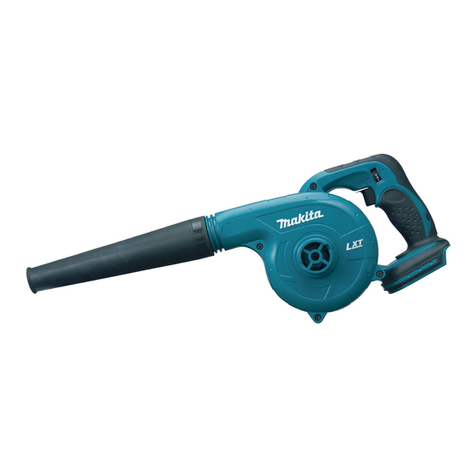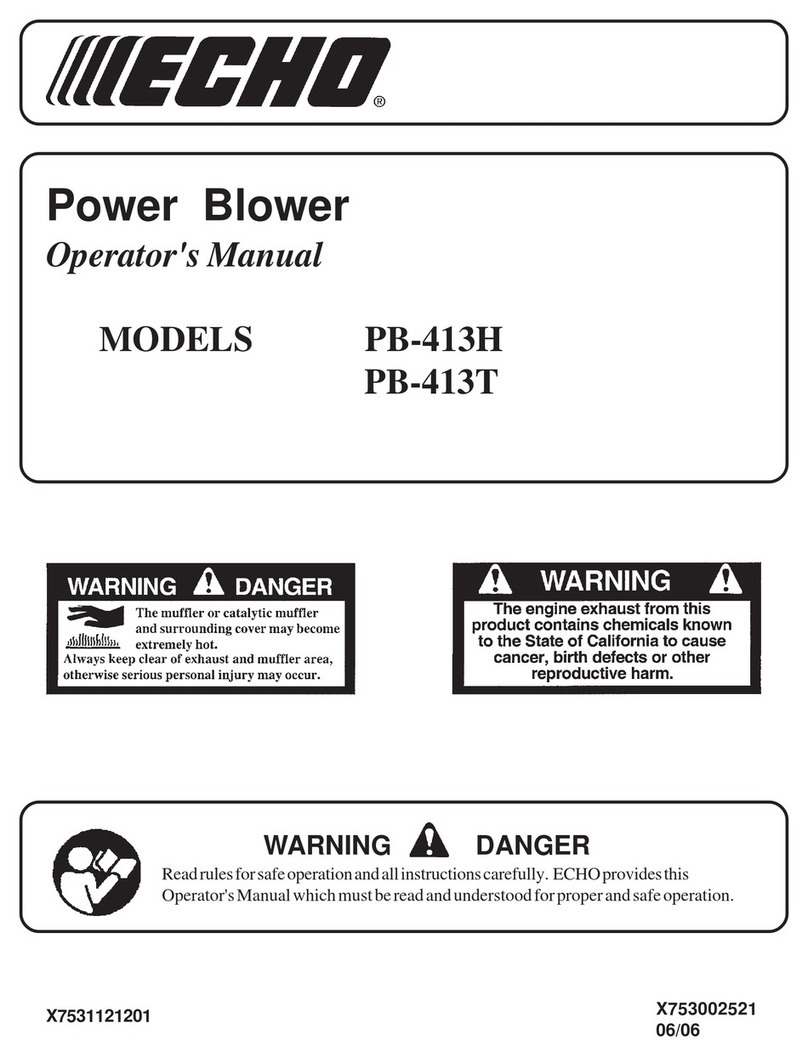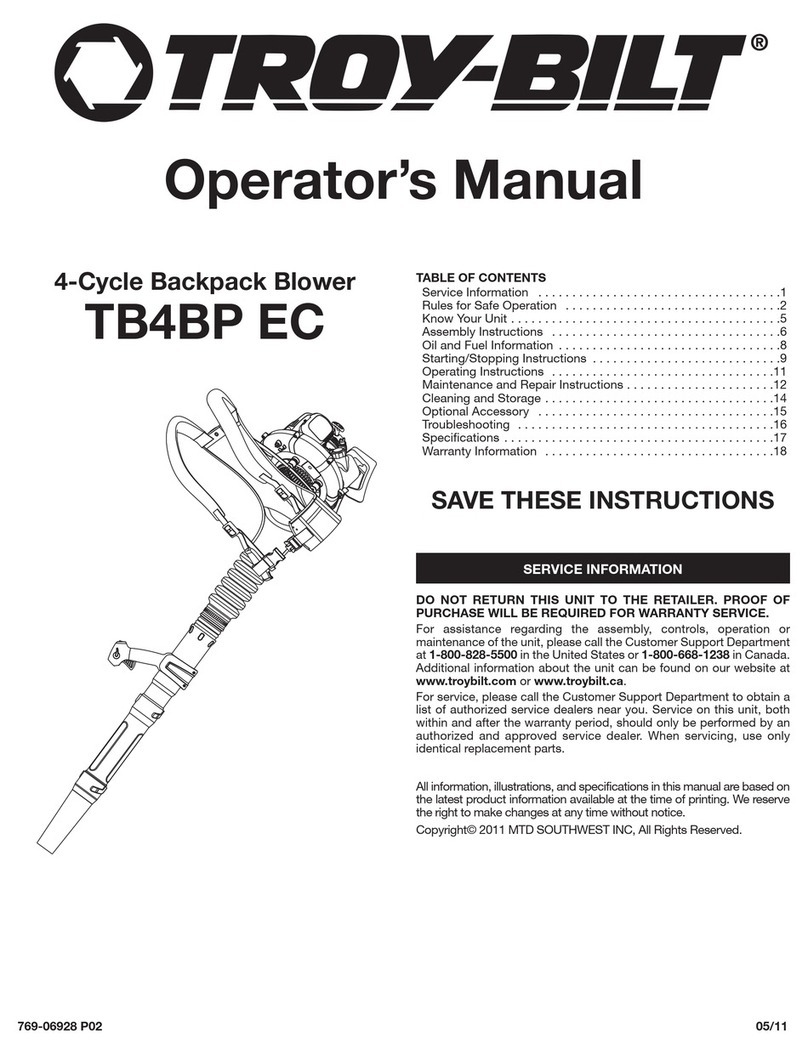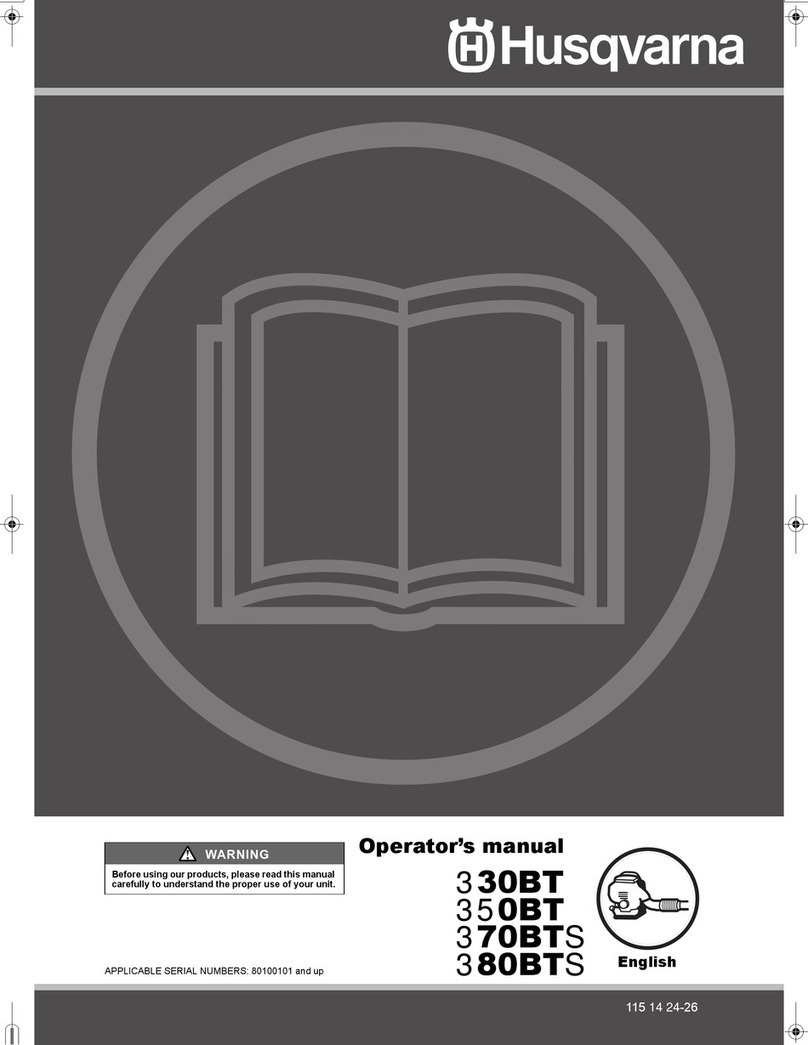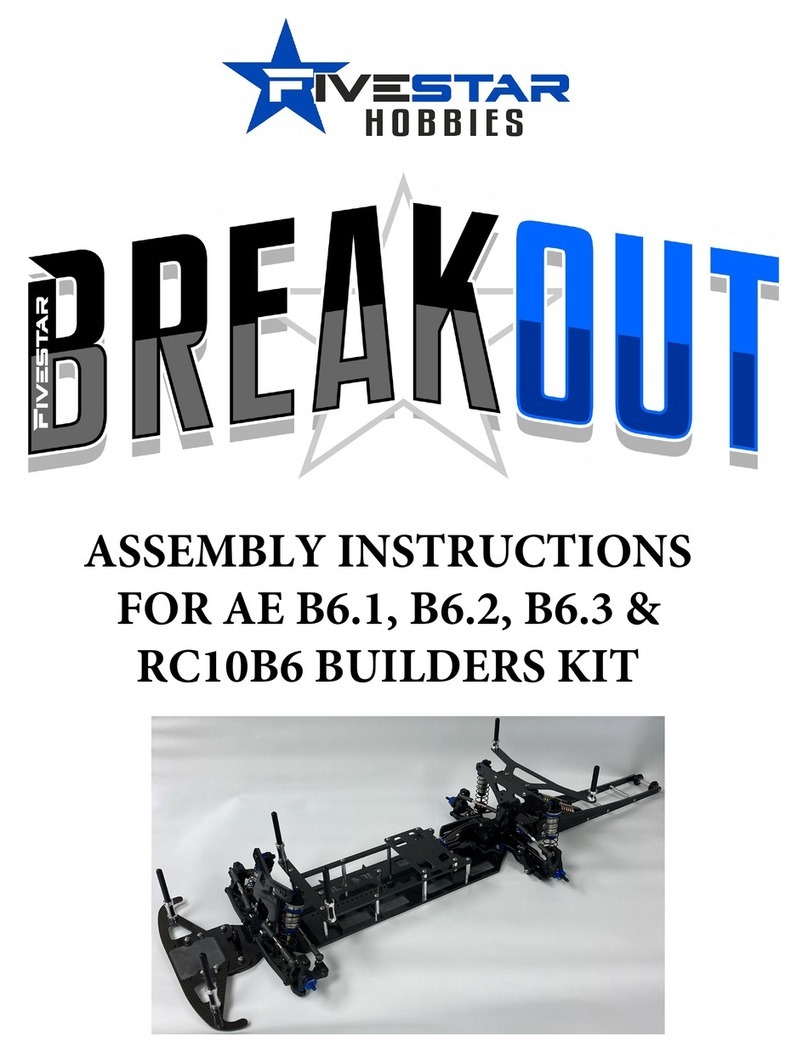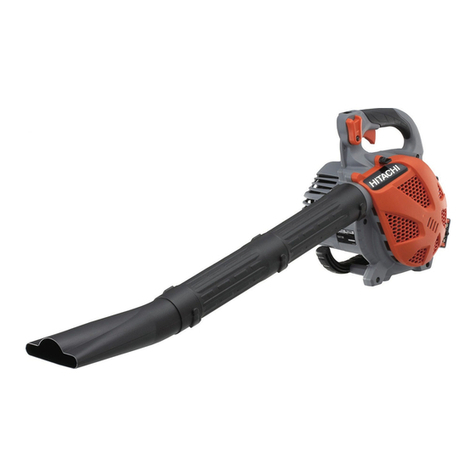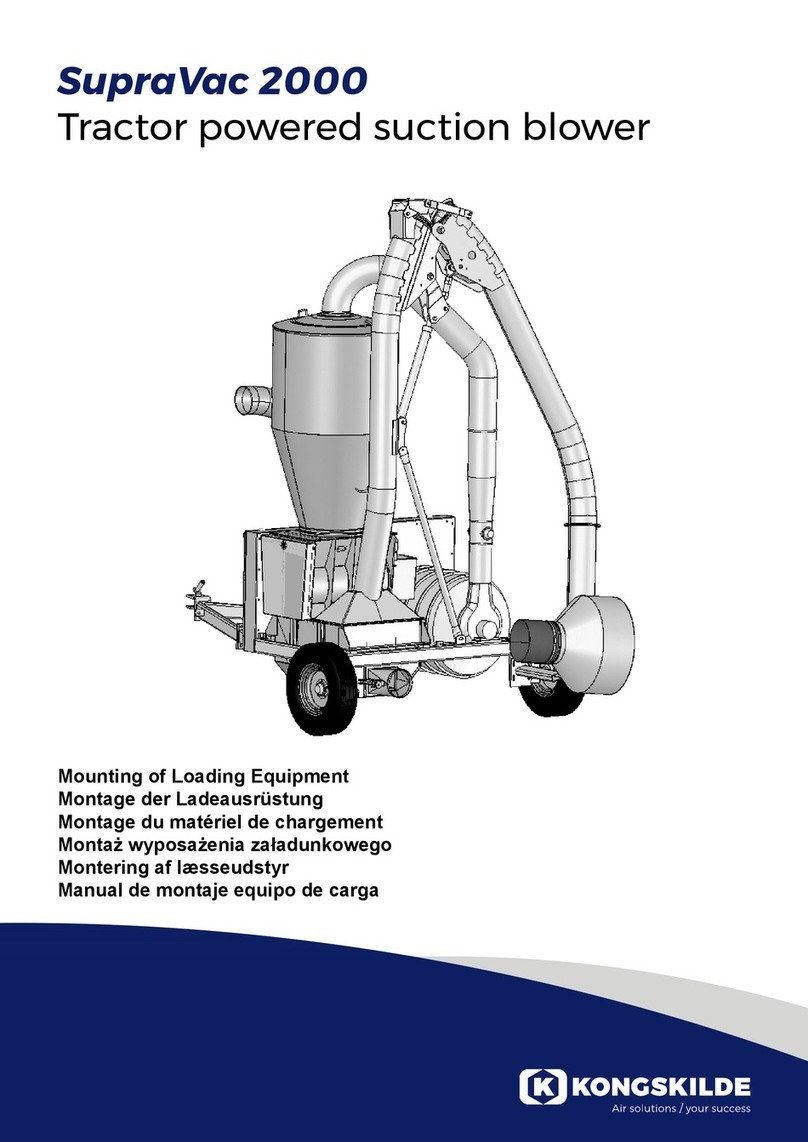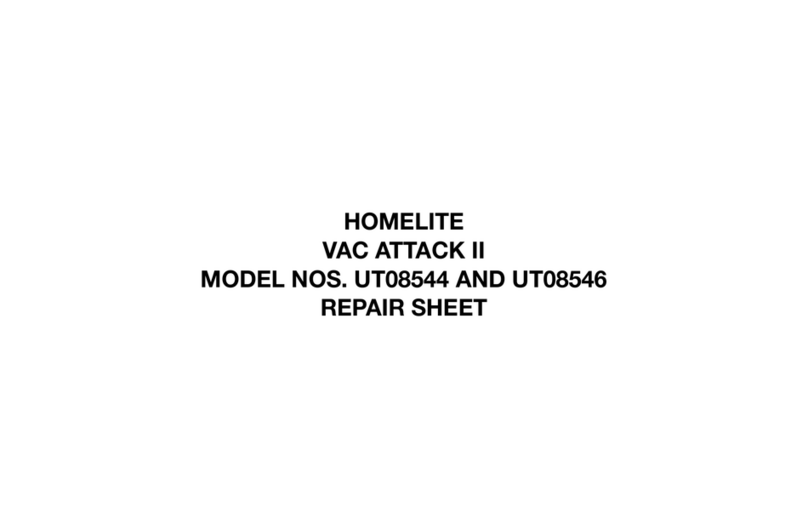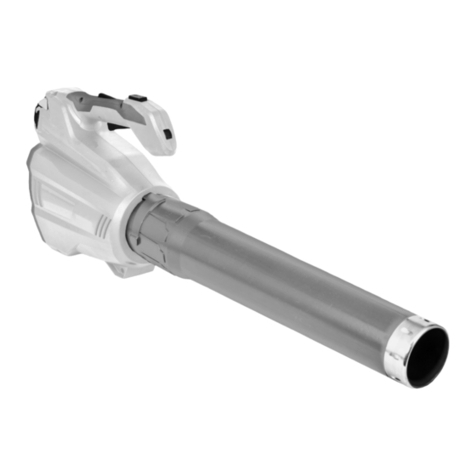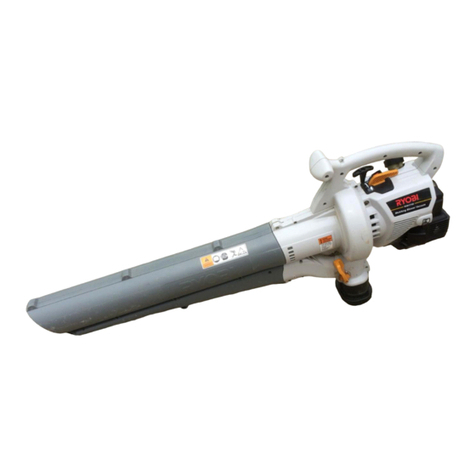Tempest VSG User manual

POWER BLOWERS®
2012 Version
ELECTRIC
Single Speed
Variable Speed
VSG
VSX
VSM
Operations
Manual
Tempest Gasoline Direct-Drives
(Honda)
Tempest Power Blower
Electric - VSM
Tempest Power Blower
Electric - VSG
Tempest Power Blower
Electric - Single Speed
Tempest Power Blower
Electric - VSX

Introduction
Page 1
TEMPEST TECHNOLOGY CORPORATION® is the leading manufacturer of products
and accessories for environmental management in reghting and industrial applica-
tions.
TEMPEST® began as a manufacturer of gasoline
and electric powered blowers for the re service.
ese departments use the TEMPEST POWER
BLOWER® to provide “Positive Pressure Ventila-
tion / Attack”(PPV/PPA) to remove heat, gases
and smoke from the interior of a burning struc-
ture.
TEMPEST® has expanded into other industries and found new applications for its
products. e TEMPEST POWER BLOWER® and PPV/PPA are used by construction
contractors to control dust, fumes and unhealthy gases like carbon monoxide, greatly
improving safety in conned spaces.
TEMPEST TECHNOLOGY CORPORATION® has earned a reputation as a leader and
innovator in the air movement industry and continues in that role today.

About This Manual
Page 2
is manual is produced solely for the use of purchasers and operators of TEMPEST
TECHNOLOGY CORPORATION® equipment. Any reproduction, retransmission, or
other use of the contents of this manual without written consent of TEMPEST TECH-
NOLOGY CORPORATION® is strictly prohibited.
It is the intent of this manual to provide the owner/operator of TEMPEST® products
with both general and specic information regarding the safe and proper operation and
maintenance of the equipment described within.
If aer careful review, any questions arise concerning any portion of this
manual, please contact TEMPEST TECHNOLOGY CORPORATION® for
assistance:
TEMPEST TECHNOLOGY CORP.®
4708 N. BLYTHE AVENUE
FRESNO, CA 93722
Toll Free: 800.346.2143
Phone: 559.277.7577
Fax: 559.277.7579
E-MAIL: response@tempest-edge.com
WEB PAGE: www.tempest-edge.com
CONTACT:

Table of Contents
Page 3
INTRODUCTION 1
ABOUT THIS MANUAL 2
CONTACT INFORMATION 2
SAFETY GUIDE 4
GENERAL INFORMATION 5
BLOWER IDENTIFICATION 5
SERIAL NUMBER LOCATION 5
WARRANTY 5
POWER BLOWER DATA 6-7
POWER BLOWER INFORMATION 8
OPERATING PROCEDURES 9-12
PRE OPERATION 9
VISUAL INSPECTION 9
OPERATION 9
SET-UP 9
STARTING, ADJUSTING, STOPPING - VSX 10
STARTING, ADJUSTING, STOPPING - VSG 11
STARTING, ADJUSTING, STOPPING - VSM 11
STARTING, ADJUSTING, STOPPING - Single Speed 12
MAINTENANCE PROCEDURES 13-16
MAINTENANCE SCHEDULE 13
BLADE REMOVAL AND INSTALLATION, 3-BOLT DESIGN 13-14
BLADE REMOVAL AND INSTALLATION, 2-BOLT REAR DESIGN 15
TROUBLE SHOOTING - VSX 16-18
TROUBLE SHOOTING - VSG 19
TROUBLE SHOOTING - VSM 20
TROUBLE SHOOTING - Single Speed 21
NOTES 22
EXPLODED VIEW - VSM & SINGLE SPEED 23
PARTS LIST - VSM & SINGLE SPEED 24
EXPLODED VIEW - VSX & VSG 25
PARTS LIST - VSX & VSG 26

Safety Guide
Page 4
Failure to follow the operating, maintenance and lubrication requirements set forth in
this Operation and Maintenance Manual may result in serious personal injury and/or
damage to equipment.
e following WARNING statements indicate potentially hazardous conditions for op-
erators and equipment. Make certain that anyone who works on or around the blower
has read and fully understands the safety precautions listed.
1. Carefully read this Operation and Maintenance Manual before attempting to
operate, service or disassemble any part of your TEMPEST POWER BLOWER®.
2. DO NOT operate the unit when mentally or physically fatigued or impaired.
3. Stay away from rotating parts; avoid wearing loose jackets, shirts, and ties. Keep
hands and feet away from the blower.
4. Keep all unauthorized personnel at a safe distance from the blower.
5. Keep all guards in place. DO NOT make repairs while the unit is running. DO
NOT operate if any guard or grill is not in place.
6. Always wear eye protection. Loose debris can be picked up in the air
stream and own in the air.
7. Hearing protection is required. Motor and air noise may exceed safe dB levels.
8. DO NOT move blower while it is running!
9. It is the sole responsibility of the owner/operator to develop and practice the
proper use of the TEMPEST POWER BLOWER® in accordance with generally
accepted ventilation procedures as well as the department’s own operating proce-
dures before placing the unit into service.

General Information
Page 5
Blower Identication
Each TEMPEST POWER BLOWER® has a model number as well as a serial number. e
model number signies information such as blade diameter, engine type and horsepow-
er. e serial number relates to information referencing the date of manufacture. is
information is useful should it become necessary to contact the factory regarding your
Power Blower.
SERIAL NUMBER LOCATIONS
ELECTRIC POWER UNITS:
e serial number is located on a small plate
welded to the frame.
Please write the Serial Number of your TEM-
PEST POWER BLOWER® in the spaces
below. is will aid us in identifying which
model you have when assisting you.
Model
Date
Serial No.
Warranty
Please visit www.tempest-feedback.com to complete your warranty information
and activate your warranty.
Blower Identication
is plate/information may be
located on the le or right side
of the Blower.

Power Blower Data
Page 6
TYPE:
Positive Pressure Ventilator
BLADE:
Air Flex Fiberglass Reinforced Polyamide
BUSHING:
Keyed Sha and Set or Cap Screws.
SHROUD:
Turbo 2000 Tapered Aluminum.
DRIVE:
Direct-drive Electric Motor.
BEARINGS:
Locking, Self-Aligning and Permanently Lubricated.
FRAME:
Rugged, Lightweight, Square-Steel Tubing with Powder-Coat Finish.
TILT MECHANISM:
Patented Five-Positions, Foot-Operated Tilt Mechanism (e Winning Step).
GRILL:
Continuous Circular-Wound, External-Weld Steel Wire with 8 Tie Points for Ad-
ditional Safety.
VIBRATION DAMPENERS:
Steel-Reinforced Rubber.

Power Blower Data Continued
Page 7
SINGLE SPEED ELECTRIC POWER BLOWERS
VSG VARIABLE SPEED BLOWERS
VSX VARIABLE SPEED BLOWERS
VSM VARIABLE SPEED BLOWERS
Model Part # Blade Size Dimensions (WxDxH) Weight CFM
EBS-16 700-108 16” 18.75” x 14.25” x 19.50” 47 lbs. 3,200
EB-16 700-099 16” 18.50” x 20.00” x 20.50” 66 lbs. 11,804
EB-18 700-056 18” 22.25” x 21.00” x 24.00” 71 lbs. 8,748
EB-21 700-060 21” 25.00” x 21.00” x 26.00” 72 lbs. 11,968
EB-24 700-062 24” 28.25” x 22.50” x 30.00” 75 lbs. 12,867
Model Part # Blade Size Dimensions (WxDxH) Weight CFM
EB-16-VSG 700-316 16” 19.25” x 19.25” x 21.25” 83 lbs. 11,125
EB-18-VSG 700-318 18” 23.50” x 20.75” x 24.00” 88 lbs. 11,861
EB-21-VSG 700-321 21” 25.50” x 20.75” x 26.25” 94 lbs. 13,414
EB-24-VSG 700-324 24” 28.25” x 21.25” x 30.00” 100 lbs. 12,901
Model Part # Blade Size Dimensions (WxDxH) Weight CFM
EB-16-VSX 700-350 16” 19.25” x 19.25” x 21.25” 86 lbs. 11,804
EB-18-VSX 700-352 18” 23.50” x 20.75” x 24.00” 91 lbs. 8,748
EB-21-VSX 700-354 21” 25.50” x 20.75” x 26.25” 97 lbs. 11,968
EB-24-VSX 700-356 24” 28.25” x 21.25” x 30.00” 102 lbs. 12,867
Model Part # Blade Size Dimensions (WxDxH) Weight CFM
EB-16-VSM 700-261 16” 19.00” x 19.25” x 21.25” 66 lbs. 10,650
EB-18-VSM 700-262 18” 22.25” x 20.75” x 24.00” 71 lbs. 8,465
EB-21-VSM 700-263 21” 25.00” x 20.75” x 26.25” 76 lbs. 11,475

Power Blower Information
Page 8
Figure 1.3
e TEMPEST POWER BLOWER® is a
high powered, portable blower used for
Positive Pressure Ventilation and Attack
(PPV/PPA), ventilation techniques that
quickly and eciently replaces hazardous
interior environments.
PPV and PPA were pioneered in the re ghting industry where re ghters use the
TEMPEST POWER BLOWER® to ventilate smoke, heat, and harmful gases from build-
ings. is creates a safer environment for them to work in and makes it easier for them
to nd victims and extinguish the re.
PPV amd PPA rely on two principles, (1) a cone shaped air pattern, and (2) pressure. To
accomplish Positive Pressure Ventilation or Attack, the blower is placed on the outside
of the structure. It is positioned so that the cone shaped air pattern created by the blower
completely seals the entrance opening (Figure 1.2). When this seal is achieved, the air
pressure is increased equally at all points inside the structure. When an exhaust opening
is created, all of the interior air moves in one mass towards it. e result is fast, ecient
ventilation of the entire structure.
NOTE:
e TEMPEST POWER BLOWER® is the most ecient tool for PPV and
PPA for two reasons. First, the exclusive Tempest tapered shroud design
creates a wide, stable, conical air pattern. Second, the seven blade air move-
ment impeller used on all Tempest blowers is designed to create high pres-
sure. ese two features make the TEMPEST POWER BLOWER® such a
powerful ventilation tool.
As with any new technique, Positive Pressure Ventilation requires training
and education in order to be implemented properly and safely. Tempest of-
fers access to a complete line of training materials, which cover many appli-
cations for this powerful ventilation technique. For more information visit
www.tempest-edge.com, www.positivepressuretraining.com or contact us at
1.800.346.2143.
Figure 1.2

Operating Procedures
Page 9
Pre-Operation
VISUAL INSPECTION
Aer receiving and unpacking your blower, be sure to carefully inspect it for any dam-
age that might have occurred during shipping. Should you nd any damage:
PLEASE NOTIFY TEMPEST TECHNOLOGY CORP.®IMMEDIATELY AT
1.800.346.2143
Operation
SET-UP, STARTING AND STOPPING
Assuming the previous Pre-Operation instructions have been followed the blower is
now ready to run.
WHEN USING A GENERATOR, IT IS IMPERATIVE THAT THE GEN
ERATOR BE RUNNING AT FULL CAPACITY BEFORE PLUGGING IN
ANY ELECTRIC BLOWER.
CAUTION: DO NOT MOVE THE BLOWER WHILE IT IS IN OPERA-
TION. SEVERE PERSONAL INJURY IS POSSIBLE AS WELL AS DAMAGE
TO THE BLOWER.
ALWAYS SHUT-DOWN THE BLOWER PRIOR TO MOVING!
SET-UP
Position the blower in the desired location, making sure it is placed on a at, hard and
debris free surface.
NOTE:
e following sections cover separate operating instructions for each type of
electric blower. Please be sure to follow the operating instructions specic to
your particular blower model. (ex. VSG, VSX, VSM, Single Speed)

Operating Procedures Continued
Page 10
STARTING - VSX (WILL NOT RUN ON GFCI CIRCUITS)
1. Plug the blower power cord into power source recep-
tacle. e following displays on the LED screen im-
mediately upon applying power:
LED ashes a 3 digit number (parameter version)
momentarily, then...
STOP condition indicator is displayed.
2. Using the INCREASE button and/or the
DECREASE button, set the desired operation
load %. Operation loads range from approximately
10% to 100%.
3. Start the blower by depressing the green button.
ADJUSTING SPEED WITH BLOWER ON
It is safe to change speed while the blower is running
simply depress INCREASE or DECREASE
buttons to set to desired speed.
STOPPING
To stop operation, depress the red button.
NOTE:
RPM setting at shut down will be the same RPM setting at restart.
CAUTION:
DO NOT plug the unit in again until the LED display is clear (blank.)
395
---
l
O

Operating Procedures Continued
STARTING - VSG
1. Check that toggle switch is set to STOP.
2. Plug the blower cord into power source receptacle. If
power is properly brought to the control, the “ON” LED
and the “STOP” LED indicators will be lit.
3. Engage START toggle. e toggle is momentary
switch to start. e center position is the run location.
STOPPING
Stop unit before unplugging from power source. Make
sure toggle is set to STOP.
STARTING - VSM
1. Set speed control knob (rheostat) to STOP.
2. Plug blower power cord into power supply.
3. Adjust rheostat to desired RPM. e GREEN LED
will indicate power is supplied to unit.
STOPPING
Turn rheostat knob to the STOP position to shut the unit o. DO NOT unplug unit
before shutting o.
Page 11

Operating Procedures Continued
STARTING - Single Speed
-NO SWITCH
Plug blower into power source. Unit will begin running
automatically.
-WITH SWITCH
1. Ensure blower toggle is switched to the o position.
2. Plug blower into power source.
3. Switch toggle to the ON position.
STOPPING
-NO SWITCH
Unplug unit from power source or switch o power source.
-WITH SWITCH
Stop unit before unplugging from power source. Make
sure toggle switch is set to STOP.
Page 12
SINGLE SPEED REQUIREMENTS
Model
Motor HP Starting
Amps Starting
Watts Running
Amps Starting
Watts
MAXIMUM POWER CORD LENGTH
Motor HP
14 gauge 12 gauge 10 gauge 8 gauge 6 gauge
EB-16 1.5 54.6 6,300 18.2 2,100
EBS-16 1/3 10.9 1,300 6.3 756
EB-18 148 6,000 16 1,900
EB-21 148 6,000 16 1,900
EB-24 1 48 6,000 16 1,900
EBS-16 215’ 330’ 550’ 850’ 1,350’
EB-16 60’ 95’ 150’ 240’ 380’
EB-18 45’ 65’ 115’ 190’ 300’
Based on 115v blower on a 20 amp circuit
Based on 1 blower on a 20 amp circuit

Maintenance Procedures
Although the Tempest Variable Speed Blowers are designed to eliminate most mainte-
nance issues, it is imperative that the blowers be inspected before startup on each use.
Please review the following list before using this product.
MAINTENANCE SCHEDULE
EVERY USE
INSPECT BLOWER FOR DAMAGE AND FIX IF ANY
TIGHTEN/REPLACE ANY LOOSE OR MISSING PARTS
INSPECT BLADE FOR NICKS/CUTS OR DAMAGE
EVERY MONTH OR 10 HOURS
INSPECT & CLEAN SHROUD & GRILLS
If the blade has made contact with a hard object, and damage has occurred, please fol-
low these simple instructions for removing and reinstalling the blade assembly.
BLADE REMOVAL/INSTALLATION
PROCEDURES
IMPORTANT: Tempest Variable and Single Speed Electric Power Blowers feature
two dierent blade to sha mount designs. When attempting to remove/install a blade
to your electric blower, you will need to identify which design your blower uses. e
instructions on the following pages touch on both designs individually. Using the im-
ages provided, match the blade-sha design you have with the ones shown in order to
decide which set of directions to follow. If you have any questions, please contact us a
1.800.346.2143
BLADE REMOVAL PROCEDURES
1. Remove the eight bolts holding the front grill in
place and remove the grill. (Figure 4.1)
Figure 4.1
Page 13

Maintenance Procedures Continued
2. Remove the three bolts from blade and remove the
blade from the hub. (Figure 4.2) Remove the two bolts
that secure the bushing to the hub. Put the two bolts in
the threaded part of the bushing and turn evenly until
bushing separates from hub.
BLADE INSTALLATION PROCEDURES
Make sure that the sha and keyway are clean and
smooth before installing the bushing. Remove the
hub from the new blade assembly.
Put “Loc-Tite” on the screws that secure the bushing
to the hub. Insert the cap screws through the clear-
ance holes in the bushing and loosely place the bush-
ing into the hub of the blade. Do not press the bush-
ing in. Hand start the screws into the hub, turning
them just enough to engage the threads in the tapped
holes on the hub. e bushing should be loose in the
hub. Place the hub and the bushing onto the motor
sha. Insert the key into the keyway (Figure 4.3) and
tighten the two bolts drawing the bushing and hub
together.
Slide the blade onto the bushing/hub assembly and place “Lock-Tite” on the three
bolts, then insert the three bolts through the blade and turn evenly but do not tighten.
Make sure blade is in line with hub then tighten bolts (Figure 4.3). Locate the blade
and bushing so that the blade tips do not hit the rear grill eyelets.
Tighten the cap screw bolts progressively with a wrench. Tighten each cap screw, par-
tial turns successively until all are tight. Final tightening should be done with torque
wrench with the torque set at 7.5 /lbs. for each screw. Over tightening will cause the
cap screws to break or crack the blade. (Figure 4.2)
Carefully turn the blade and check for clearance between the blade and shroud. Con-
rm that the blade is free to rotate without hitting other parts.
Reinstall the front grill and test the blower.
If you have any trouble removing or installing the blade on your blower, contact the
factory for assistance at 1.800.346.2143.
1.
2.
3.
4.
5.
6.
7.
NOTE:
On some models the blade and bushing may be in beyond or out away from the end
of the sha up to ¼” but no further. is is necessary for proper blade clearance.
Figure 4.2
Figure 4.3
Page 14

Maintenance Procedures Continued
BLADE REMOVAL PROCEDURES
Remove the eight bolts holding the front grill in
place and remove the grill. (Figure 4.1, Page 13)
Remove the three Allen bolts from blade/hub assem-
bly. DO NOT remove the four nuts/bolts holding
the two blade hub halves that secure the blade ns.
(Figure 5.1)
Insert bolts into adjoining threaded holes of blade/
hub assembly, hand tighten.
(Figure 5.2)
With Allen wrench, consecutively tighten bolt 1,2,3
half turn and repeat until blade separates from bush-
ing.
BUSHING REMOVAL
Loosen Allen set screw. Insert small screw driver into
bushing slot applying a little pressure to release bushing
from engine sha. (Some bushings may have a set screw
securing the bushing to the key on the motor sha). Be
careful not to damage end of sha. (Figure 5.3)
BLADE INSTALLATION
Check key. A worn key should be replaced. Make
sure motor sha keyway is clean.
Align bushing keyway with sha key and position
bushing on sha to insure blade ns are centered
between front and rear grill mounting bolts. Put blue
“Loc-Tite” on bushing allen set screw and tighten.
Align non-threaded holes of blade/hub assembly
with threaded holes of bushing. Put lock washers on
bushing bolts. Put blue “Loc-Tite” on bushing bolts.
Insert through non-threaded holes of blade/hub as-
sembly, hand tighten. With Allen wrench tighten
bolts 1,2,3 consecutively until tight, torque to 7
pounds. (Figure 5.4)
Reinstall the front grill and test the blower.
1.
2.
3.
4.
1.
2.
3.
4.
Figure 5.1
Figure 5.2
Figure 5.3
Figure 5.4
Page 15

Trouble Shooting - VSX
Many factors can contribute to or be the sole cause of problems for electric power blow-
ers. is section will identify some of these problems and provide solutions to correct
them.
BLOWER FAILS TO START
MAKE SURE BLOWER IS CONNECTED TO POWER SOURCE.
IF LED DISPLAY DOES NOT LIGHT UP:
Conrm that adequate power is being supplied to blower. If power supply is adequate,
DISCONNECT BLOWER FROM POWER SOURCE and check for loose or faulty wir-
ing on blower electrical system and repair.
Connect blower to power source and attempt restarting, if blower still does not run,
contact Tempest at 1.800.346.2143.
IF LED DISPLAY LIGHTS UP AND:
Fault Code is given, reference Fault Code Table on the next page for diagnostics.
If “---“ appears on LED, but motor does not run, DISCONNECT BLOWER FROM
POWER SOURCE and check wiring between drive and motor, repair any faulty wiring.
Also check to ensure that the EPM chip is fully inserted into the socket on the top of the
blower control. Connect blower to power source and attempt restarting, if blower still
does not run, contact manufacturer.
BLOWER RUNS THEN CUTS OFF
Check generator rating. e VSX blower series requires minimum 3.5kw rating for
maximum load operation.
Aer the blower cuts o, check the fault code reading on the LED. Reference the fault
code chart on the next page.
Figure 5.1
Figure 5.2
Page 16

Trouble Shooting - VSX
FAULT CODES
FAULT DESCRIPTION & POSSIBLE
CAUSES
ACTION
JF KEYPAD FAULT: THE COM-
MUNICATION LINK BE-
TWEEN THE DRIVE AND
THE KEYPAD HAS BEEN
LOST.
CHECK KEYPAD WIRING AND MAKE
NECESSARY REPAIRS.
LF LOW DC BUS VOLT-
AGE FAULT: TYPICALLY,
CIRCUIT BREAKER HAS
TRIPPED DUE TO EXCES-
SIVE AMP DRAW.
L. CHECK CIRCUIT BREAKER SIZE,
RECOMMENDED SIZE FOR VSX SE-
RIES IS 20 AMP. CHANGE CIRCUIT
BREAKER IF TOO SMALL.
LL. CHECK GENERATOR KW RATING,
IF TOO SMALL, UPGRADE GENERA-
TOR, OR RUN BLOWER LOWER THAN
MAXIMUM BLOWER SPEED.
LLL. CHECK LINE VOLTAGE AT J-
BOX RECEPTACLE. LINE VOLTAGE
SHOULD BE 120V, ±10%. MAKE NEC-
ESSARY ADJUSTMENTS TO INSURE
PROPER SUPPLY VOLTAGE.
LLLL. CHECK FOR UNDERSIZED
POWER SUPPLY CORD. ACCEPTABLE
CORD IS 10/3 AWG X 200 FT. MAX.
CHANGE CORD ACCORDINGLY.
PF CURRENT OVERLOAD
FAULT: EXCESSIVE CUR-
RENT DRAW BETWEEN
DRIVE AND MOTOR.
L. CHECK FOR UNDERSIZED POWER
SUPPLY CORD. ACCEPTABLE CORD
IS 10/3 AWG X 200 FT. MAX. CHANGE
CORD ACCORDINGLY.
Page 17

Trouble Shooting - VSX
CHANGING EPM PROGRAM CHIP
When replacing the EPM (program chip), use a ¼” nut driver to remove the opposing
self tapping screws on the black cover of the VSX box. e EPM is located in the upper
le corner of the white controller under a small piece of protective lm. Remove the
tape and using needle nose pliers, remove the EPM and replace with new one. Replace
the tape over the EPM, replace black cover and opposing screws.
BLOWER MOVEMENT OR “WALKING”
• Adjust the rubber footpads on the back of the Blower by turning them either in or out.
Adjust the side that is walking. is will help to evenly distribute the weight of the
Blower to all four points of the frame
• Most Blowers will walk if not running at full speed, make sure the Blower is running at
full speed.
• Make sure the Blower is sitting at and not on small rocks or other objects.
Page 18

Trouble Shooting - VSG
Many factors can contribute to or be the sole cause of problems for electric power blow-
ers. is section will identify some of these problems and provide solutions to correct
them.
MAKE SURE BLOWER IS CONNECTED TO POWER SOURCE.
IF THE “ON” AND THE “STOP” LEDS DO NOT LIGHT UP:
Conrm that adequate power is being supplied to blower. If power supply is adequate,
DISCONNECT BLOWER FROM POWER SOURCE and check for loose or faulty wir-
ing on blower electrical system and repair.
Connect blower to power source and attempt restarting, if blower still does not run,
contact Tempest at 1.800.346.2143.
BLOWER RUNS THEN CUTS OFF:
Check that the overload indicator light is lit. If the light is lit, this means there is insu-
cient voltage going to the unit. is can be caused by too long of a extension cord, faulty
extension cord or low voltage from the power source. If none of the above exist, the unit
may be set to draw more amperage than the power supply delivers. If this is the case,
there is an adjustment inside the drive to correct the amperage draw when running at
100%. Please contact Tempest for instructions.
BLOWER SURGES WHEN RUNNING ON GENERATOR:
Check generator that it meets the proper voltage output to operate the blower.
BLOWER MOVEMENT OR “WALKING”
• Adjust the rubber footpads on the back of the Blower by turning them either in or out.
Adjust the side that is walking. is will help to evenly distribute the weight of the
Blower to all four points of the frame
• Most Blowers will walk if not running at full speed, make sure the Blower is running at
full speed.
• Make sure the Blower is sitting at and not on small rocks or other objects.
Page 19
This manual suits for next models
18
Table of contents
Other Tempest Blower manuals
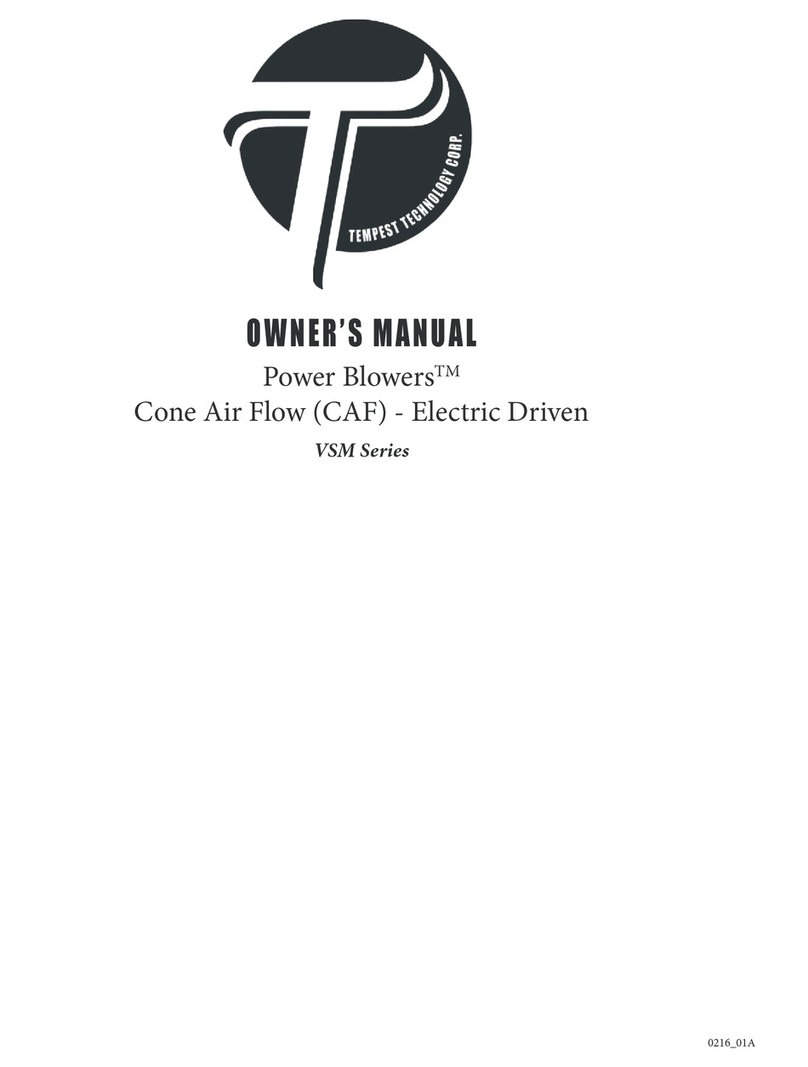
Tempest
Tempest VSM Series User manual
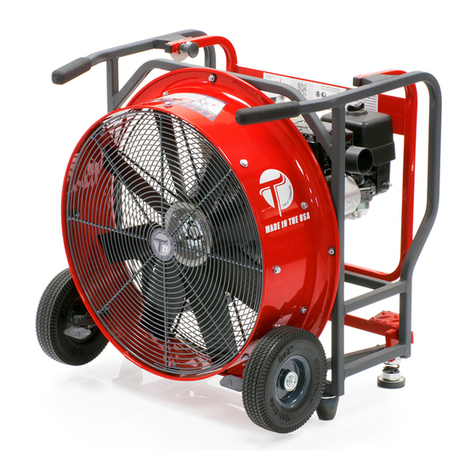
Tempest
Tempest POWER BLOWER User manual
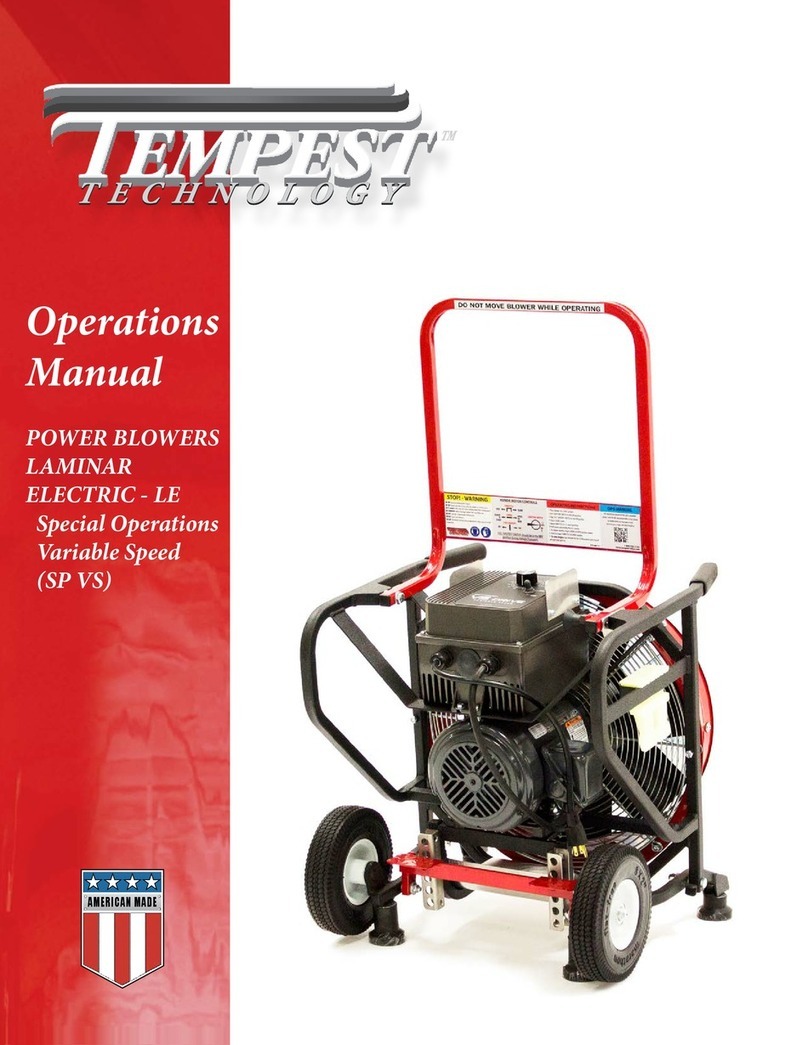
Tempest
Tempest LAMINAR ELECTRIC - LE User manual

Tempest
Tempest VS1-18-BLDC User manual
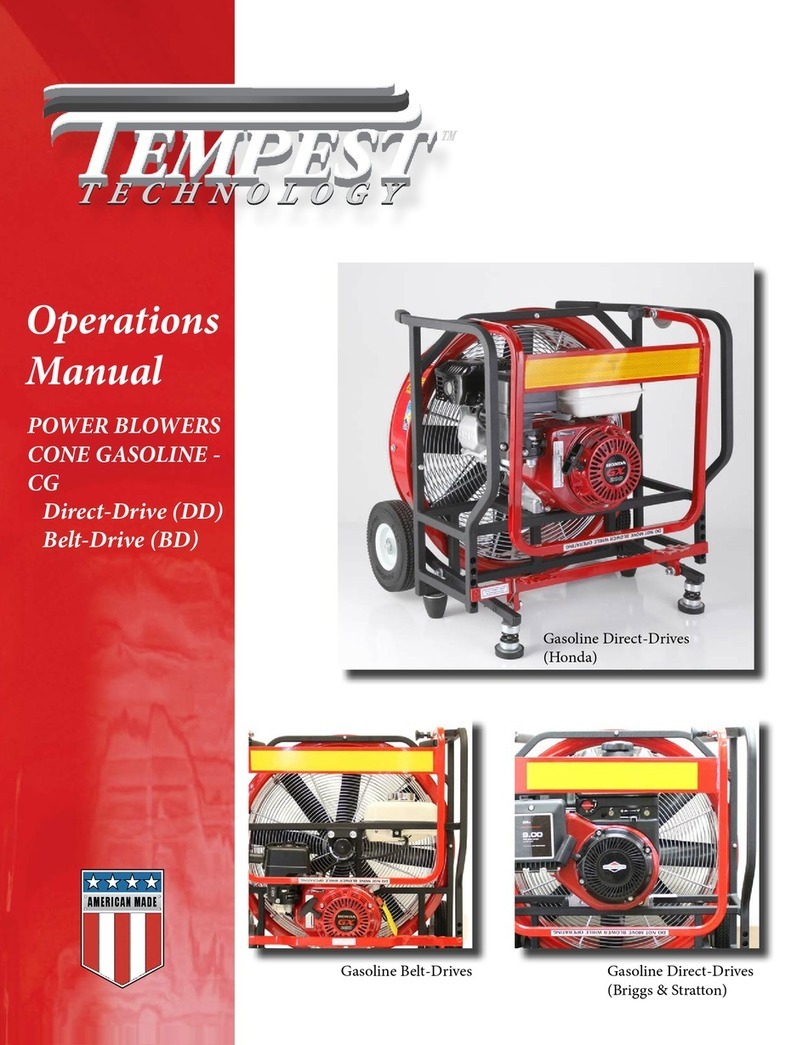
Tempest
Tempest BD-21-H-6.5 User manual
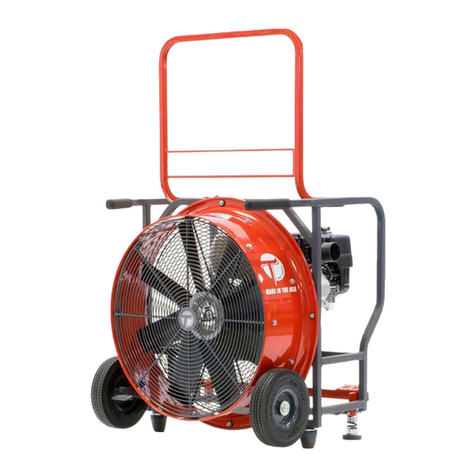
Tempest
Tempest Power Blower Direct-Drive Series User manual
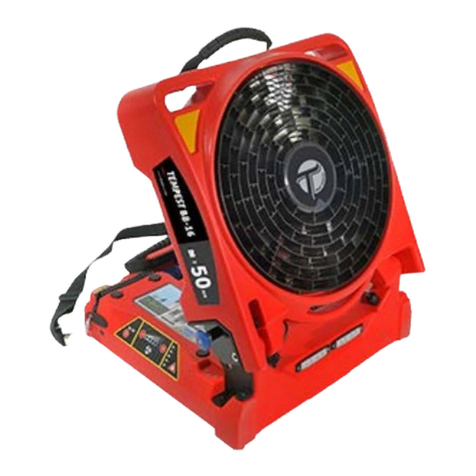
Tempest
Tempest BB-16 User manual
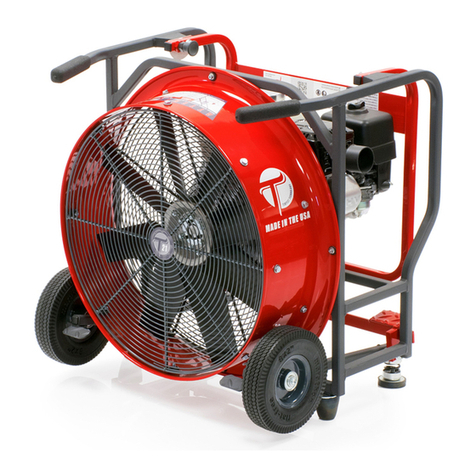
Tempest
Tempest Direct-Drive User manual

Tempest
Tempest SP Power Blower User manual
